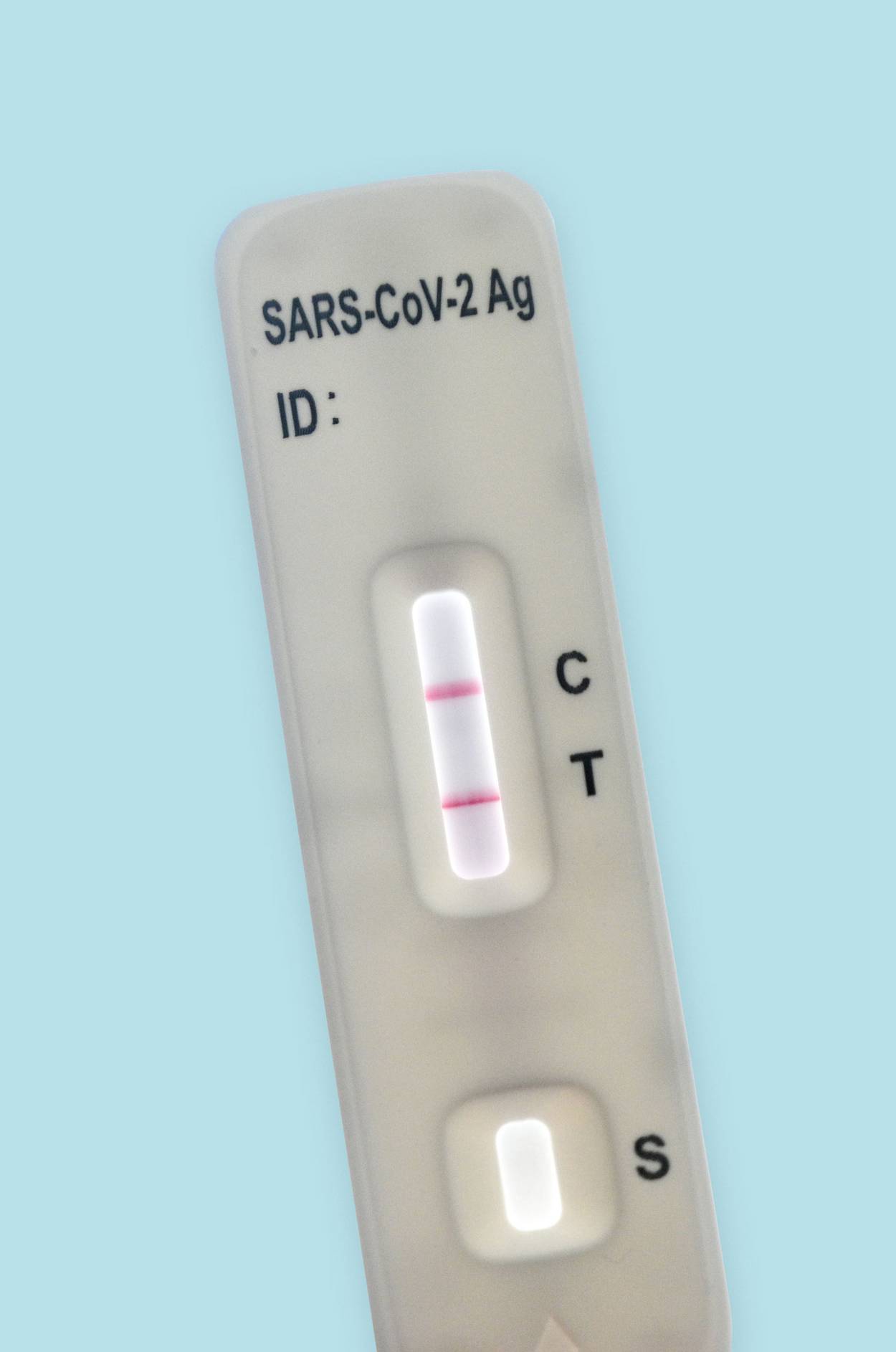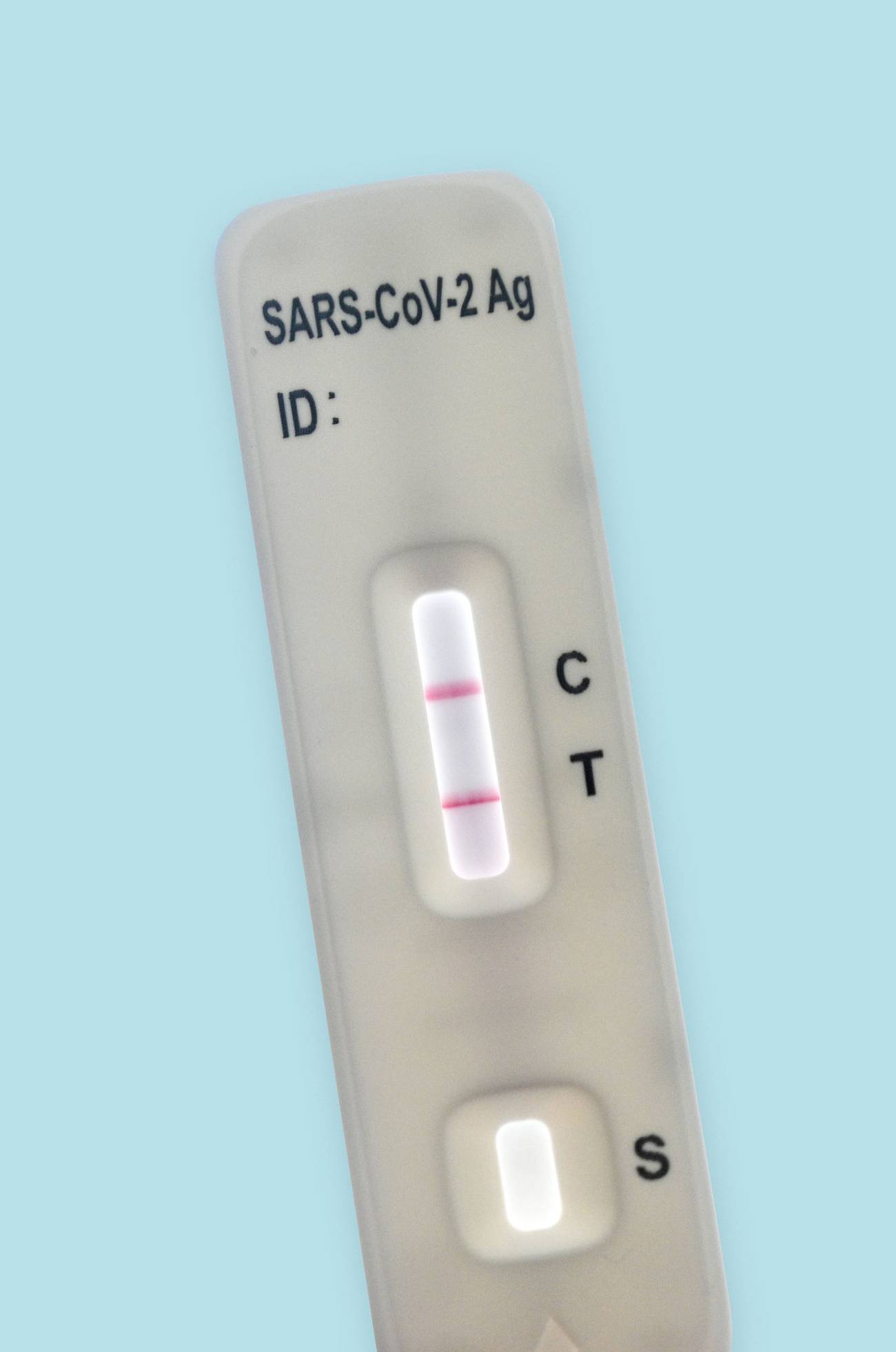Testing Positive
After two years of being careful and getting vaccinated, I finally got COVID-19




I finally caught COVID-19. Two years into the pandemic. Yes, for the first time—to the best of my knowledge. Obviously, catching coronavirus in March 2022 is very different from catching it in March 2021, not to mention March 2020. It’s sort of like wearing bell-bottoms in 1983 or shoulder pads in 1998. But, some say, better late than never. So it was with a mixture of mild relief, curiosity, and the slight embarrassment of jumping on the bandwagon too late that I accepted my fate.
At the beginning of March, both my sons (both twice vaccinated, both in elementary school) tested positive, one after the other. That was during the time when Israel’s ever-changing national school policy was that children need to take a home rapid antigen test (RAT) twice a week in order to attend school (that policy was canceled the day both my sons finished their quarantine after testing positive). So, every Sunday and Wednesday, all parents (or at least the obedient ones) shoved the famed Q-tips up their kids’ noses. The entire thing felt like a game: Whoever got two stripes had to stay home the next day.
When our eldest got two stripes, we were all in shock. He felt fine, and the whole thing felt like we just pulled a bad card from the “Chance” deck in Monopoly. After a gazillion earlier tests had come out negative, seeing a positive one felt like seeing a unicorn.
The even stranger thing was sending his brother to school the next day. We called his teacher and the coronavirus supervisor of the school—every school in Israel now has one—and they both told us that if he’s feeling fine, is vaccinated twice, and has a negative RAT, he’s welcome to come to school, even if his brother is positive. “But we’re not isolating him from his brother,” we explained. “Still,” they said. This would have been unheard of a year or two before; the time when anyone who came in contact with someone positive was sent into immediate isolation and removed from society wasn’t so long ago, but policies and attitudes change. Rapidly.
Two days after the older one, the little one turned positive, too. Another seemingly healthy child with no symptoms and two stripes. Now we had two kids in isolation at home while we were expected to work and function in the world—back to the good ol’ days of lockdown. Except that this time we were allowed to roam freely. The gap between regulation and common sense never felt wider, but it seems most people didn’t care that we had two positive kids at home and didn’t hesitate to meet us. “But we’re not isolated from the kids,” we explained. “Still,” they said.
The whole time the kids had it, my partner and I didn’t catch it. Jokes regarding our parenting skills aside (“maybe you don’t hug them enough”), we came out negative every single day. Plus, we weren’t afraid of them. Even while both my kids were positive at home, I continued sitting in fear on the bus, giving the crooked eye to whomever didn’t have a mask on, and moving to another seat if anyone coughed—old habits die hard—but at home I was with my kids as usual. Maybe it’s an evolutionary mechanism that a mother can’t be afraid of her children. Who knows?
For a while we both felt that we were invincible, physically incapable of catching COVID. People around us laughed.
“Your turn will come,” they warned.
“But we didn’t catch it from the kids and we were together in the house 24/7,” we explained.
“Still,” they said, and started reciting their personal stories: Apparently in every family, some of the members were infected at some stage while others resisted, only to follow suit soon after.
They were right. Two weeks after the kids were declared recovered, and no longer considered a danger to society, our wall of insolence cracked—seemingly with no connection to them (my better half probably caught it from his sister and passed it on to me) and not because we let our guard down and stopped being careful either (honest!). Rational explanations I have none, but the fact is that my partner started feeling bad on Friday night. His RAT came out negative, but he had a hunch. He went for a PCR test Saturday morning and got the positive result by text message in the evening. He texted me with the news while I was sitting with a friend in a pub (outside seating!). Now I was sure I was going to get it. My first instinct was to look at my calendar for the upcoming week.
Nowadays when you find out you’re positive, friends don’t ask you how you’re feeling, they ask you how good or bad the timing is. The current variant going around—omicron or whatever replaced it—is very mild and usually nothing to really worry about. So, if your COVID falls on a hectic time at work that you would rather avoid, you got it good. If it falls on important events you’d rather not miss, you got a raw deal. And it’s not all up to chance, either. You can try and manipulate and influence this, even however slightly. It’s all a math game. According to common sense, I wouldn’t hurry to get a PCR test before I have any symptoms or have a positive RAT. According to common sense, I would also not wish to come out positive on my PCR. But things being what they are, I rushed to get a PCR as early as possible, and hoped for the worst.
Policies and attitudes change. Rapidly.
Sometime between getting the PCR on Sunday morning—in a special tent located outside the local library—and getting my positive result, that same evening, I started to feel sick. Weak, trembly. With a mild throat ache. But that was secondary in importance. My main goal was to get an official positive result ASAP in order to increase my chances of leaving isolation-jail before the next Saturday, since we had a big event planned for that day. Apart from that Saturday’s event, my son was pretty upset that we caught COVID the week of his school field trip as his dad was supposed to chaperone the trip. In the end, though, the trip was canceled due to terrorist attacks across the country. That’s reality for you.
The era of COVID has been an ongoing global exercise in what the woke generation refers to as gaslighting. Who exactly is the gaslighter in this scenario remains unclear—the virus? the government? the media?—but if healthline.com defines gaslighting as “a form of emotional abuse that makes you question your beliefs and perception of reality,” then we’re all victims of abuse.
Reality has never been this elusive: Is COVID really so bad? Maybe it isn’t? Is COVID the devil or is it just a flu with public relations, as the cliché goes? The fact that the notorious virus that shut down malls, schools, and airports, and in Israel alone reached a death toll of over 10,000, is currently treated as a mild annoyance (at least in Israel) is very confusing. And what’s worse is knowing that this can change again at any moment. I remember a sweet and naive moment after everybody got their second vaccine, that we sat in a little smoke-filled bar in Ben Yehuda Street (inside!) and talked about coronavirus in the past tense. I remember adding “tfu tfu tfu” at the end, to ward off the evil eye and ensure I didn’t jinx it. It didn’t help. It wasn’t too long before the fifth wave was upon us, and the short-lived normality was gone again.
I’m obviously not the first to comment that maybe the psychological damage created by this epidemic is way greater than the health aspect on the general population. Or maybe it isn’t. For the past two years, our beliefs and perception of reality have been changing daily, sometimes several times a day. Friends promised that catching coronavirus would put an end to the confusion and these endless ruminations. I don’t feel like it did. I still fear possible future variants, I still fear the unknown, and I still feel an all-encompassing feeling of instability.
If I weren’t feeling paranoid enough, the next day I got a text message from something called PoliceCovid. It asked me to give my agreement for technological supervision under quarantine. At first, I thought it was sent by a hacker trying to break into my phone. Google revealed it was really sent by the Israeli police, but I doubt anyone with COVID symptoms could muster up the strength to actually read the Terms of Use of Technological Supervision Methods required to agree or decline the offer.
The illness itself, on the other hand, wasn’t so bad. Being vaccinated three times and in good health generally, it indeed felt like a flu. For most of the week we sent the kids out into the world on their own—the big one took the little one to school and back, and did the grocery shopping—while we lay in bed, prohibited from leaving the house. Four days in, I got to the conclusion that the fact that yesterday I felt much better than the day before and today I felt really awful again was part of COVID’s devilish plan to play tricks on my mind. I know that generally things are supposed to get worse before they get better, but I’m trying to remember if the saying mentions anything about things getting better and then worse again and better again and worse again, maybe ad infinitum—or if this is just the course of COVID.
This seesaw effect is part of the illness, as well as the discourse surrounding it. Sometimes COVID is propagated as something to be avoided at all cost, and in other times it’s sold as “really not so bad.” I caught COVID a month after the Russian invasion of Ukraine, and since news outlets started devoting much more coverage to the war in Eastern Europe than to the epidemic, Israelis started declaring that “corona is over.” Who knows?
The days passed. Saturday rolled around and so did the spring get-together we were all waiting for. Six days after my positive result. According to current regulations in the country, you’re free to leave the house after seven days. In order to get released early—after five or six days—you need two negative RATs on two consecutive days, and no symptoms. So up the Q-tip went. When the second stripe in a home pregnancy test is very weak, they remind you that there is no such thing as a half-pregnancy. But there is, it turns out, such a thing as a half-positive. Or a mostly negative. The weaker your second stripe is, the closer you are to it being over. And mine grew gradually paler as the week progressed. To be officially released from isolation you need two negative RATs, on day four and five, and no symptoms. Friday evening my RAT was almost all clear. The second stripe was barely noticeable, and apart from mild fatigue, I felt fine. I WhatsApped the hostess and all attendees a clear photo of my test. They deemed it fine. “But if you squint, you can still sort of see the second stripe,” I insisted. “Still,” they said. Most of them already had COVID anyway. Plus, it’s just COVID.
Dana Kessler has written for Maariv, Haaretz, Yediot Aharonot, and other Israeli publications. She is based in Tel Aviv.